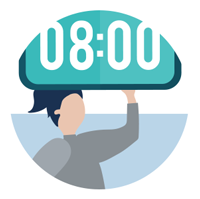-
The Best 25-Step Customer Service Training Guide
Wed, 15 May 2019, in Customer Service
Liking this one? You might also enjoy 3 Secrets for the Best Customer Service with One Employee

If you have great customer service agents, you’ll get loyal customers that repurchase and recommend you to everyone in their circle. That’s where your training program comes in.
Along with crafting a catchy posting at a career site, scheduling interviews and hiring the best candidate, investing in customer service training is probably the most valuable thing you can do for the long term success of your business. It’s also one of the most effective ways an organization can connect with its customer base: by better understanding and faster resolving their issues.
Simply spending more time on your employees (including looking for the right skills, hiring the right individual, ensuring a rewarding work environment) is important and all, but it’s certainly not the complete picture. The other part is a well-functioning customer service training program, essentially the “glue” that motivates and gets your employees doing their best, which by extension, keeps your customers interested in you.
Read More: New Customers vs. Return Customers: What’s the Difference?
It should come as no surprise that training your customer service team is just as important as offering great customer service in the first place. More so, the perfectly trained customer service team will bring you more sales, lower your marketing costs, encourage loyalty (from team members as well as the end-user) and create a self-sustaining culture of customer success throughout your company.
The way you approach your customer service training depends on your organization. The skills and knowledge you want your trainees to absorb, the language and behavior you want them to utilize, and the degree of self-learning or self-autonomy you want them to have.
Why train for customer service anyway?
Imagine you’re starting a new job and receive no training at all. No matter how well you think you know the job, no matter how quick and talented you may be, you’ll be doing a lot of guesswork when working together with others or trying to best position yourself within the company.
Training does more than the obvious (that is, prepare you for your new role).
How you get trained affects your first impression of the company and give you a glimpse of your journey ahead. Naturally, it also affects your quality of work. When it comes to customer service, it can make a difference between a helpful, enthusiastic response and a mediocre one.
After you identify the right customer service skills and properly vet your new hires, you’ll have to settle on the type of training you want to provide. Before you come up with a training program for new staff, you should step back and consider your overall training strategy (now’s a good time as any!)
One-time training

Companies launch new products or enact changes that can affect their customers constantly. Managers end up scrambling to get everyone on the same page (particularly in large organizations).
For example, when we release a new Helprace feature, we anticipate an increase in questions about it. That’s why we publish new documentation and add it to a saved response, as well as an internal note (with internal documentation) with a specific tag. This not only helps customers, but gets employees up to speed quickly, too.
Product updates
Whenever your product undergoes changes, your website or contact form gets a makeover, make it a priority to get all your employees up to speed as fast as humanely possible.
Train for better supportKeep training short not to overload your audience and consider having a small test session at the end. Do the way they speak about the product in the context of the recent updates make sense?
Crisis periods
Being prepared for emergencies means reacting to them the right way. When an unscheduled downtime or outage occurs, your team needs to be updated thoroughly so they can respond in the best possible manner.
Train for the right responsePrepare your course of action beforehand and try to get everyone trained all at once. Don’t wait until a crisis or emergency happens to inform everyone about how they should act.
New tools
What happens when you adopt a new tool or change how you use it? Some tools in your arsenal may be unrelated to your product, but you should still keep up with them (and get that across to your team).
Train for productivity and efficiencyDecide how much time you want to train for each tool based on how crucial it is to your sales, marketing or customer service efforts.
Ongoing training

Keeping your skills fresh is the key to customer service excellence. Determine your training structure and how often you want to do it. Every quarter, half-year, or more often than that?
For example, we at Helprace have a “review” period where we go over some of the more negative support experiences and have a brainstorming session about how we could have improved. In the end, everyone (and not only our support staff) benefits from this!
Skills refresh
Customer expectations don’t stay static over time, and neither should your support department. Even if they come naturally, certain skills must be reinforced and maintained through regular training intervals.
Conduct role-playing activitiesTry mock calls that resemble a real issue common in your company. Proper crisis management and handling of difficult situations is imperative in keeping customers satisfied long term.
Team building
Team building activities gets everyone comfortable in working together. A sense of teamwork, purpose and direction is otherwise difficult to promote without team building training.
Introduce friendly competition and gamesHere is a really fun list of 20 team building activities you can use. They can act as team energizers, helping with communication and problem-solving.
Industry updates
If you’re in an industry that goes through changes often, you’ll need to conduct training sessions for employees to relearn regulations, industry standards or keep up to date with legal requirements.
Look at what your competitors are doingWhat kind of customer service and customer experience your competitors offering? If someone raises the bar in your industry, you’d better be aware and know how to deliver that to your team.
Training new hires
First days and weeks are tough for any customer support employee. Depending on the size of your organization or your support workflows, your onboarding may need to stretch over weeks and even months.
Excellent training and onboarding is essentially effectively introducing a new person to your existing working environment, but also a tremendous learning experience for the rest of the team. As you go over the support process, the interaction between team members, documentations and various tools that they use, you can make them feel comfortable early on – and that’s crucial for smooth sailing.
Introduction stage
Time period: 1-2 days

Onboarding
Before you even dive into training, spend the first day (or two) in a pressure-free social environment where everyone can get to know each other. Get your new hires comfortable where they are.
Schedule an after work event, as a team lunch or a round-the-office tour might feel rushed for a true introduction.

Training structure
Optimize the structure of your training from start to finish. Plan out every day, including breaks, and leave enough room for questions and the possibility of tailoring training to individuals.
Give your new hire an outline of the whole training process, including quick list of resources, office codes, etc.

Product
Devote the most time for theoretical and practical product training. No matter how great your agent is at communicating, they’ll be struggling to help customers if they don’t know your product well enough.
Ready a “get started” guide for your recent hires with the most crucial features, useful shortcuts and internal documentation.

Support tools
Spend some time explaining the basics of the tools they’ll be relying on. Explain the roles of each tool and how they all work together to reach company goals.
Include in your guide a list of tools, screenshots and their commands. This can act as a reference during training.

Support process
What is your typical support interaction like? Do you expect certain phrases to be used? How are your various support channels handled, support requests escalated, and so on.
Draw a support flowchart, one that describes the customer support process from start to finish (with some examples).
Soft skills stage
Time period: 1 day

Positivity
Part of being positive is about aligning your words and actions in a positive manner to present customers a solution. This is an essential skill when bearing bad news or in conflict resolution.
Consider training exercises where you replace negative (or neutral) words with positive ones, as well as pointing out differences in tone.

Empathy
Whether it’s a happy, inspirational story or hearing about a negative situation, we tend to be empathetic by default. Train support employees to easily see things from the customer’s perspective.
Tell a story (or ask your trainee) about a bad experience with a product. How did it make them feel and what did they end up doing?

Clarity
Keep an eye on how your trainee is conveying their thoughts to you. Can you understand them easily? Will your team and customers be able to understand them, both in written and spoken form?
Get a trainee to present a complicated product fix to you as though you were a new customer. Limit them to five sentences or a few minutes.

Decision-making
What if the manager is not available? Your agents should be able to individually make difficult decisions. Figure out what warrants an “executive decision”, a certain type of customer or a certain situation.
Consider support situations involving angry customers. Include examples with customers constrained by time, money, personal problems, etc. Ask your trainees how they would act.

Self-control
Understand the temptation of anger, irritation, procrastination, etc. Train your employees to have a positive outlook, to control their reaction to emotions, and to allow difficult support situations affect the next one.
Ask your trainees what irritates them, what they have trouble dealing with. Ask how they calm themselves, how best to convey that “this is ok, nothing to be worked up about”.
Technical skills stage
Time period: 2-3 days

Demonstrations
Demos can help communicate ideal customer service situations as you see it in your mind. You can demonstrate challenging requests that touch upon billing, discounts or refunds.
Think of simulations: envision situations and ask trainees how they would react. Ask them for reasons for doing so. Avoid role playing, where trainees assume positions not natural to them (this could be useful in the soft skills stage, however.)

Small-big
Don’t expect your new staff to come up to speed all at once. Assign tasks with a complexity level of 1-5. Start trainees on a tasks with complexity of 1-2 for the first day, for example.
Now is the time to finally give the reins to your employee. Start employees on only one support channel with an easy ticket queue (for example, “login problems”, “account change” or “feature requests”.)

Mentorship
A mentor is someone experienced in the support team, someone not too overzealous, or disingenuous either. Pick someone with enough product knowledge to coach and guide support trainees on real cases.
Pick someone from a different department, team or someone at a higher level within the company. This can give the trainee a new perspective, help break the ice and give them a better understanding of their tasks.

Shadowing
Job shadowing refers to a mentor is left to work on their task themselves, with the trainee pitching in with questions or for clarification. This is effective when the trainee is already comfortable with the basics.
Be aware of overstaying welcomes. Working while someone’s breathing over your shoulder can be uncomfortable. Have trainees pitch in by leaving internal notes in tickets, as well as link to internal knowledge base articles if needed.

Trial runs
Fit in some alone hands-on time in your training. No matter how much time you spend in the classroom, practical experience will likely be the best way for your employees to learn and retain information.
During the last half of the day, give your new agent an opportunity to fly solo. Get them the freedom to work by themselves but be available if they have any questions.
Additional activity stage
Time period: 1 day (as needed)

Feedback management
Get your customer support staff involved in feedback logging and fix prioritization. Using the right tool (such as the Helprace idea portal) they can prioritize feedback via email, phone or portal.
Support requests, complaints can all be seen as customer feedback in disguise. Get your agents to escalate these requests as feedback and follow up with the customer if any progress is made.

Customer webinars
If your staff are assigned to only one support channel, get them over on a different one once in a while. Another great opportunity for your support reps is participating in screen sharing sessions including sales or conference calls.
They know your product and customers better than anyone, so why not get your best customer service staff to prepare a transcript and host a webinar or perform a one-on-one crash course session.

Company blog
Involve your support staff in your content marketing efforts, including blogging and email marketing. This can add much-needed variety to your content and hone up your employee’s writing and communication skills in the process.
Why not have a support employee write a blog post on their desired topic of interest every three months? Aside from switching up their activities, it can prove to be a welcome opportunity to share their insights with the world.

Help documentations
Get your agents to pitch in with your help documentation. If you have a self-service portal or a FAQ site with a manger, you can move over some of their tasks (or give your agent the role of a proofreader).
Don’t stop at your support documentation. If you have automatic actions, ticket tags, or canned responses in your help desk, you can get support employees provide suggestions on improving your workflows.

Embrace improvement
Your trainees are a perfect source of finding out what works and what doesn’t in your product. Take the opportunity to collect their feedback on your training program.
Could you offer training on different mediums, such as video, text, discussion, etc? Test out other platforms, document the feedback and make the data available to the right echelon of your company.
Post-training
Time period: ongoing

Track progress
There are many ways you can collect data on your employees and new hires. Aside from understanding how they stack up against one another, you’ll get a better understanding of what to expect and how to improve your training.
Track training progress on your side (grades, assessment, milestone tracking) as well as the trainee’s side (pop quizzes, awards). Share accomlishments and skill progression with your employees.

Rewards system
You want your employees to value their workplace and grow in their role, while maintaining camaraderie and friendly competition. Rewards systems are great in recognizing unexpected, outstanding achievements beyond the regular line of duty.
How you assign a reward might be more important than the reward itself. Does your team decide who gets it? Is everyone competing against themselves or against customer (or company) benchmarks?

Guidelines, not rules
Part of empowering employees means curbing reliance on scripts in support. More than that, it’s about trust and believing your employees will do what’s right on your behalf.
Why did you hire him or her? Likely, because you have some trust in their abilities. So give them the freedom to do their best. If you can’t remove the rule book, at least implement feedback from your employees to improve it.

Out-of-office activities
Once in a while, treat your team to an event outside of work, unrelated to work. Think of team coaching events, team retreats where everyone can get to know each other better on a personal level.
Over time, employees will know all about your product and their job. What about learning about each other, over a game of baseball, or a barbecue? These types of connections can’t be made in the confines of an office.

Open Culture
One great way for customer service agents to continue learning throughout their career in support is by establishing the right culture. Build a team that welcomes everyone and all types of discussions.
Introduce a tradition of openness, where everyone can call on each other if they need help. Try out a system of rotating employee pairing or having a “go to” guy in the team.
In conclusion…
While “hiring the right person” may seem like the ultimate cheat code to better customer service, the reality is much different.
That is, a customer service representative is often times one of the company’s most crucial roles with a lot of responsibility. The individual entrusted with such responsibility becomes the eyes, ears and face of the brand, whose words and actions are a reflection of the brand’s philosophy.
Sure, there’s a lot that goes into proper, effective customer service training.
That’s why it’s important to approach training as a comprehensive, long-term process that can always be improved upon. Your training program must be flexible, be able to accommodate a constant alignment and re-alignment of the individual element within the context of team and company.
Great customer service matters, and it always will. Ultimately, it’s your competitive advantage: a way to get customers to choose you over someone else and do it often. It’s in your best interest to prepare your customer service team to deliver on that promise, against all possible odds.
Read More: How to Inspire Employees to Care About Customer Service
Tags: customer service, customer service skills, customer service training

